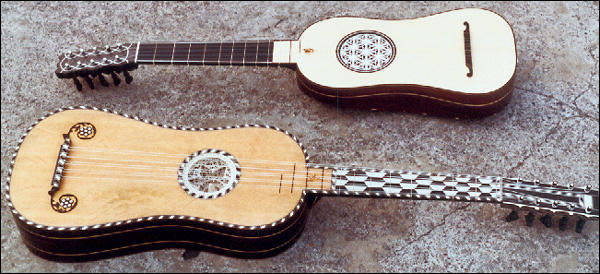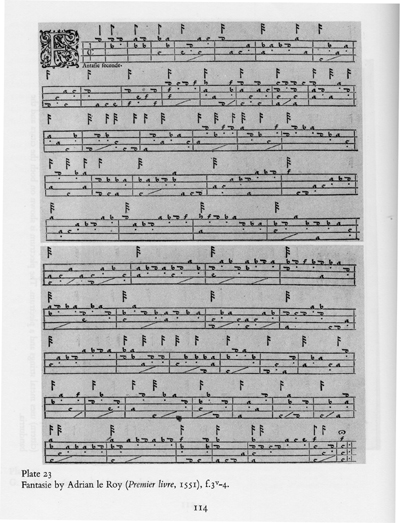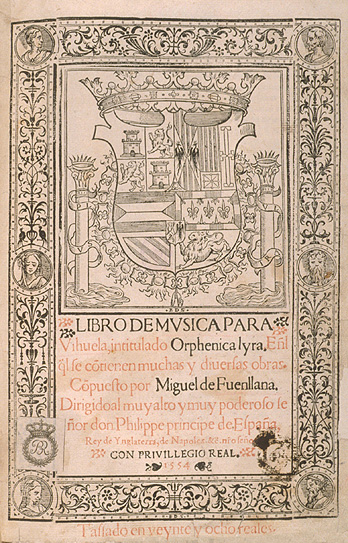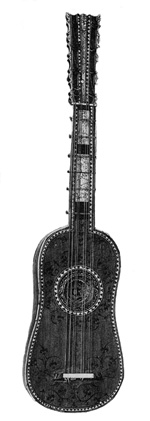THE FOUR-COURSE RENAISSANCE GUITAR

Above in the foreground a copy of the 1641 René Voboam guitar in the Ashmolean, Oxford, alongside a copy of the 1581 Belchior Dias guitar in the Royal College of Music, London.

Renaissance guitar based on the plantilla of the Belchior Dias guitar
Vaulted back of 11 ribs; back and sides in walnut, neck and pegbox in walnut
or pearwood; pernambuco pegs; wood & parchment rosette. String length:
540mm Pitch: a' (tuning: a' - e' - c' - g )
Spanish called it guitarra;
Italians, chitarra de sette corde or chitarrino;
French, guiterre
or guiterne and the English, gittern
or cetterne.
Juan Bermudo in his "Declaracion de Instrumentos" (1555) describes the guitarra as having four courses tuned as the second to fifth courses of the vihuela. Mudarra describes it as having ten frets and a bordón on the fourth course at an octave below.
TUNINGS

Playing plucked instruments in ensemble was a common practice at the time, this led to the gradual transition from modal music to the modern major minor tonality system. In lute and guitar music we see the beginnings of an entirely new view of music. The vocal traditions that had governed, such as accidental placement, where left to the discretion of the singers who followed certain conventions. Instrumental music written in tablature, begins to show chromatic alterations that broke conventional rules of vocal music, opening the way to a new system of harmony. We see the beginnings of polyphony when instrumentalists begin to read separate melodic lines producing simultaneous chordal movements, all the parts could be read together without adhering to vocal musical conventions.
The contributions of Pierre Attaignant (1494-1552) Royal Printer, who in 1528 published the first of a series of more than seventy books of songs, provided much material for lutenists and guitarists. In these books we find songs by Claude de Sermissy (ca. 1490-1562), Clement Janequin (ca. 1485-1558), Pierre Certon (ca. 1512-1572) and poetry by Clement Marot (1496- 1544) and Saint -Gelais (1491-1558). Between 1529 and 1531 Attaignant published ten collections of instrumental music. Later in his life he published many more to please the new market for dance music with a great variety of instruments, and music for the soloist.
It was in France, where the guitar flourished, with publications by Guillame Morlaye, Simon Gorlier, Gregoire Braysing, and Adrian Le Roy. Between 1550 ande 1555 nine books were published. The repertoire consisted of fantasias for solo guitar, voice and guitar, and dances for consort where the guitar plays a leading role. The fantasias of Morlaye, Brayssing and da Rippa (in Morlaye's fourth book) are complex and deserving of study by guitarists, and the dances of Le Roy's are stated twice, once in simple setting and the second time embellished with plus diminueé, with florid quick passages in virtuoso style similar to those found in the lute repertoire of the time.
 |
 |
Morlaye Fantasia#1 from Le Troisieme Livre (1551)


Renaissance four course guitar built by Lawrence Brown.
The most important books in Italy and Spain for the four course guitar are:
Mudarra's "Tres
Libros de Musica en Cifra" 1546 it has four Fantasias, Pavane
and Guárdame Las Vacas.
Melchior De Barberis "IntitulitoContina" 1549
contains four Fantasias for guitar.
Miguel de Fuenllana "Orphenica Lira" 1554
nine pieces, six are imitative Fantasias for 3 and 4 voices.
Tablature from Orphénica Lyra by Miguel de Fuenllana (1554). The red numerals (cifra colorada) printed in the tablature of the piece shown above indicate the voice part.
 |
 |
In England:
The guitar became very important with James Rowbotham's publication of a method book, he also translated Adrian Le Roy's lute books, the first lute tutor book printed in England. Most guitar music in England appeared in lute books like Ralph Bowle's lute book (1558) and Thomas Mulliner's in (1570).
The last book published
in England was John Playford "A
Book of New Lessons for Cittern and Guittern" 1650, this book
was full of ballads and tunes of popular music specially effective when leading
a consort.
The book that reached the most people in Europe was "Anthology
of Guitar Music" (1570) by Jean Bellere
and Pierre Phalèse containing 182 pieces of music
from various composers.
In Italy:
Girolamo Giuliani published his "Intavolatura de Chitarra" ca. 1580's, this book is lost to us but we can assume it was for a four-course instrument. The guitar appears in ensemble with other instruments in important Oratorios such as Emilio de' Cavalieri's Rappresentazione di Anima et di Corpo were we find three small guitars in ensemble.
|
 Chitarrino
by Giovanni Smit, (1646) Vienna. The sounding string length is ca. 51
cm. Chitarrino
by Giovanni Smit, (1646) Vienna. The sounding string length is ca. 51
cm. |
© 2006 Patricia A. Dixon